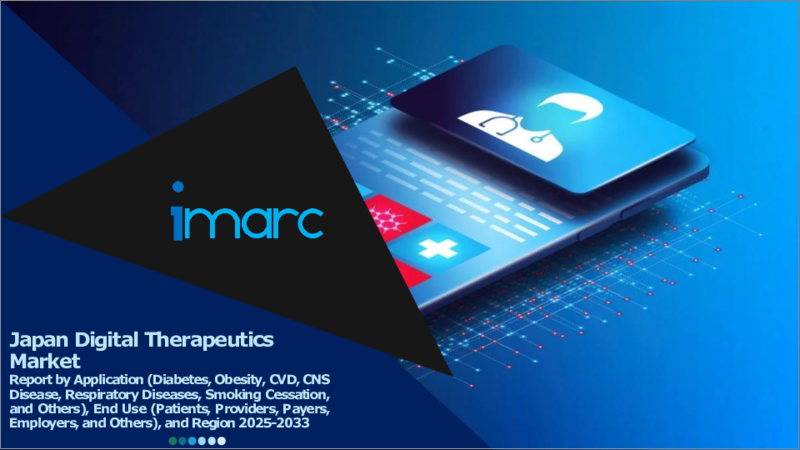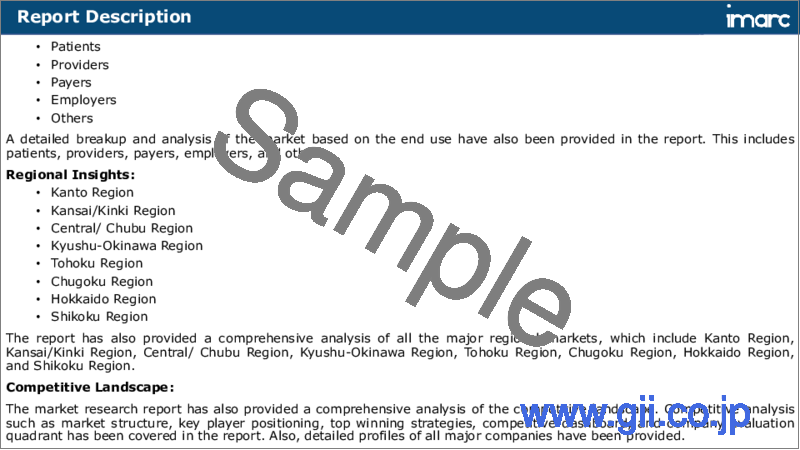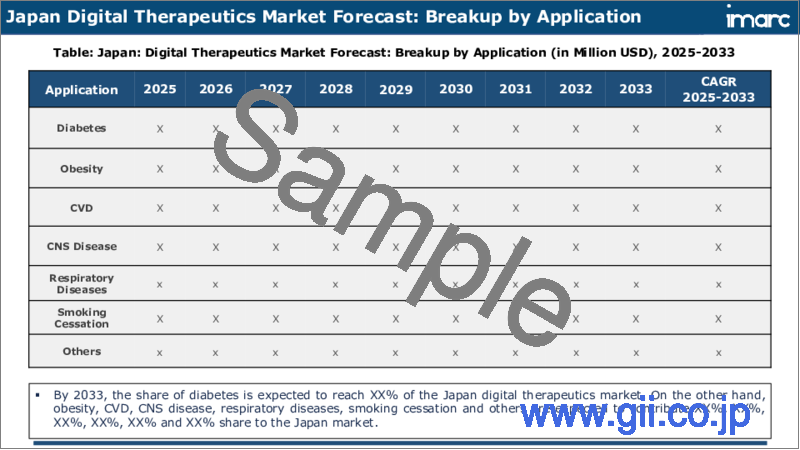|
|
市場調査レポート
商品コード
1747016
デジタル治療の日本市場:用途別、最終用途別、地域別、2025年~2033年Japan Digital Therapeutics Market Report by Application (Diabetes, Obesity, CVD, CNS Disease, Respiratory Diseases, Smoking Cessation, and Others), End Use (Patients, Providers, Payers, Employers, and Others), and Region 2025-2033 |
||||||
カスタマイズ可能
|
|||||||
| デジタル治療の日本市場:用途別、最終用途別、地域別、2025年~2033年 |
|
出版日: 2025年06月02日
発行: IMARC
ページ情報: 英文 121 Pages
納期: 5~7営業日
|
全表示
- 概要
- 目次
日本のデジタル治療市場規模は2024年に3億1,950万米ドルに達しました。今後、IMARC Groupは、市場は2033年までに19億2,450万米ドルに達し、2025年から2033年の間に20.43%の成長率(CAGR)を示すと予測しています。関節炎、心血管合併症、糖尿病、骨粗鬆症などの様々な慢性疾患の有病率の増加、人工知能(AI)や機械学習(ML)の進歩の高まり、明確なガイドラインや枠組みの確立の増加は、市場を牽引する主な要因のいくつかを表しています。
本レポートで扱う主な質問
- 日本のデジタル治療市場はこれまでどのように推移し、今後どのように推移していくのか?
- COVID-19が日本のデジタル治療市場に与えた影響は?
- 日本のデジタル治療市場の用途別区分は?
- 日本のデジタル治療市場の最終用途別区分は?
- 日本のデジタル治療市場のバリューチェーンにおける様々なステージとは?
- 日本のデジタル治療の主要な促進要因と課題は何か?
- 日本のデジタル治療市場の構造と主要プレーヤーは?
- 日本のデジタル治療市場における競合の程度は?
目次
第1章 序文
第2章 調査範囲と調査手法
- 調査の目的
- ステークホルダー
- データソース
- 市場推定
- 調査手法
第3章 エグゼクティブサマリー
第4章 日本のデジタル治療市場 - イントロダクション
- 概要
- 市場力学
- 業界動向
- 競合情報
第5章 日本のデジタル治療市場情勢
- 過去および現在の市場動向(2019~2024年)
- 市場予測(2025~2033年)
第6章 日本のデジタル治療市場 - 用途別内訳
- 糖尿病
- 肥満
- CVD
- CNS系疾患
- 呼吸器疾患
- 禁煙
- その他
第7章 日本のデジタル治療市場 - 最終用途別内訳
- 患者
- 提供者
- 支払者
- 雇用主
- その他
第8章 日本のデジタル治療市場 - 競合情勢
- 概要
- 市場構造
- 市場企業のポジショニング
- 主要成功戦略
- 競合ダッシュボード
- 企業評価象限
第9章 主要企業のプロファイル
第10章 日本のデジタル治療市場 - 業界分析
- 促進要因・抑制要因・機会
- ポーターのファイブフォース分析
- バリューチェーン分析
第11章 付録
Japan digital therapeutics market size reached USD 319.5 Million in 2024. Looking forward, IMARC Group expects the market to reach USD 1,924.5 Million by 2033, exhibiting a growth rate (CAGR) of 20.43% during 2025-2033. The growing prevalence of various chronic diseases like arthritis, cardiovascular complications, diabetes, and osteoporosis, rising advancements in artificial intelligence (AI) and machine learning (ML), and increasing establishment of clear guidelines and frameworks represent some of the key factors driving the market.
Digital therapeutics are software-based interventions designed to bring about positive health outcomes by modifying patient behavior and providing clinical support. They comprise behavioral therapy apps, which focus on modifying behavior patterns to address mental health conditions, such as stress, anxiety, and depression. They also include chronic disease management platforms, which help patients monitor and manage their conditions through features like medication reminders, activity tracking, and personalized health recommendations. They encompass remote patient monitoring, which involves the use of wearable devices and sensors to monitor the vital signs and health metrics of patients remotely. They rely on scientific evidence and clinical trials to ensure their effectiveness. They often undergo rigorous testing to validate their impact on specific health outcomes. They prioritize user engagement by providing personalized and interactive experiences. They may include features like real-time feedback, progress tracking, and user-friendly interfaces. Digital therapeutics are designed to complement traditional healthcare approaches. They can integrate with electronic health records (EHRs) and connect patients with healthcare providers for seamless coordination of care. They are useful for post-surgery recovery, chronic disease management, and eldercare. They increase access to healthcare by providing convenient and cost-effective solutions. Digital therapeutics can offer a cost-effective alternative to traditional treatments.
Japan Digital Therapeutics Market Trends:
At present, the increasing demand for digital therapeutics as they contribute to better health outcomes by actively involving patients in their care and continuously monitoring and personalized interventions represents one of the crucial factors impelling the growth of the market in Japan. Besides this, the rising prevalence of various chronic diseases like arthritis, cardiovascular complications, diabetes, and osteoporosis is driving the adoption of innovative and effective treatment modalities. Digital therapeutics addresses the increasing burden of chronic illnesses due to its ability to deliver personalized and remote interventions. In addition, the growing advancements in technology, particularly in the realms of artificial intelligence (AI) and machine learning (ML), are empowering digital interventions to analyze vast datasets, personalize treatment plans, and continuously adapt to individual patient needs. The integration of wearables, sensors, and other connected devices further enhances the capability of digital therapeutics to collect real-time health data, providing clinicians with valuable insights for informed decision-making. Apart from this, the increasing shift towards value-based care models and a focus on preventive healthcare is accelerating the adoption of digital therapeutics as a cost-efficient strategy for managing chronic conditions in the country. Regulatory bodies, patients, and healthcare providers are also recognizing the economic benefits of investing in digital interventions that not only treat but also prevent the exacerbation of chronic diseases. Additionally, the rising establishment of clear guidelines and frameworks for digital therapeutics approval and integration into mainstream healthcare is supporting the market growth in the country.
Japan Digital Therapeutics Market Segmentation:
Application Insights:
- Diabetes
- Obesity
- CVD
- CNS Disease
- Respiratory Diseases
- Smoking Cessation
- Others
End Use Insights:
- Patients
- Providers
- Payers
- Employers
- Others
Competitive Landscape:
The market research report has also provided a comprehensive analysis of the competitive landscape. Competitive analysis such as market structure, key player positioning, top winning strategies, competitive dashboard, and company evaluation quadrant has been covered in the report. Also, detailed profiles of all major companies have been provided.
Key Questions Answered in This Report:
- How has the Japan digital therapeutics market performed so far and how will it perform in the coming years?
- What has been the impact of COVID-19 on the Japan digital therapeutics market?
- What is the breakup of the Japan digital therapeutics market on the basis of application?
- What is the breakup of the Japan digital therapeutics market on the basis of end use?
- What are the various stages in the value chain of the Japan digital therapeutics market?
- What are the key driving factors and challenges in the Japan digital therapeutics?
- What is the structure of the Japan digital therapeutics market and who are the key players?
- What is the degree of competition in the Japan digital therapeutics market?
Table of Contents
1 Preface
2 Scope and Methodology
- 2.1 Objectives of the Study
- 2.2 Stakeholders
- 2.3 Data Sources
- 2.3.1 Primary Sources
- 2.3.2 Secondary Sources
- 2.4 Market Estimation
- 2.4.1 Bottom-Up Approach
- 2.4.2 Top-Down Approach
- 2.5 Forecasting Methodology
3 Executive Summary
4 Japan Digital Therapeutics Market - Introduction
- 4.1 Overview
- 4.2 Market Dynamics
- 4.3 Industry Trends
- 4.4 Competitive Intelligence
5 Japan Digital Therapeutics Market Landscape
- 5.1 Historical and Current Market Trends (2019-2024)
- 5.2 Market Forecast (2025-2033)
6 Japan Digital Therapeutics Market - Breakup by Application
- 6.1 Diabetes
- 6.1.1 Overview
- 6.1.2 Historical and Current Market Trends (2019-2024)
- 6.1.3 Market Forecast (2025-2033)
- 6.2 Obesity
- 6.2.1 Overview
- 6.2.2 Historical and Current Market Trends (2019-2024)
- 6.2.3 Market Forecast (2025-2033)
- 6.3 CVD
- 6.3.1 Overview
- 6.3.2 Historical and Current Market Trends (2019-2024)
- 6.3.3 Market Forecast (2025-2033)
- 6.4 CNS Disease
- 6.4.1 Overview
- 6.4.2 Historical and Current Market Trends (2019-2024)
- 6.4.3 Market Forecast (2025-2033)
- 6.5 Respiratory Diseases
- 6.5.1 Overview
- 6.5.2 Historical and Current Market Trends (2019-2024)
- 6.5.3 Market Forecast (2025-2033)
- 6.6 Smoking Cessation
- 6.6.1 Overview
- 6.6.2 Historical and Current Market Trends (2019-2024)
- 6.6.3 Market Forecast (2025-2033)
- 6.7 Others
- 6.7.1 Historical and Current Market Trends (2019-2024)
- 6.7.2 Market Forecast (2025-2033)
7 Japan Digital Therapeutics Market - Breakup by End Use
- 7.1 Patients
- 7.1.1 Overview
- 7.1.2 Historical and Current Market Trends (2019-2024)
- 7.1.3 Market Forecast (2025-2033)
- 7.2 Providers
- 7.2.1 Overview
- 7.2.2 Historical and Current Market Trends (2019-2024)
- 7.2.3 Market Forecast (2025-2033)
- 7.3 Payers
- 7.3.1 Overview
- 7.3.2 Historical and Current Market Trends (2019-2024)
- 7.3.3 Market Forecast (2025-2033)
- 7.4 Employers
- 7.4.1 Overview
- 7.4.2 Historical and Current Market Trends (2019-2024)
- 7.4.3 Market Forecast (2025-2033)
- 7.5 Others
- 7.5.1 Historical and Current Market Trends (2019-2024)
- 7.5.2 Market Forecast (2025-2033)
8 Japan Digital Therapeutics Market - Competitive Landscape
- 8.1 Overview
- 8.2 Market Structure
- 8.3 Market Player Positioning
- 8.4 Top Winning Strategies
- 8.5 Competitive Dashboard
- 8.6 Company Evaluation Quadrant
9 Profiles of Key Players
- 9.1 Company A
- 9.1.1 Business Overview
- 9.1.2 Product Portfolio
- 9.1.3 Business Strategies
- 9.1.4 SWOT Analysis
- 9.1.5 Major News and Events
- 9.2 Company B
- 9.2.1 Business Overview
- 9.2.2 Product Portfolio
- 9.2.3 Business Strategies
- 9.2.4 SWOT Analysis
- 9.2.5 Major News and Events
- 9.3 Company C
- 9.3.1 Business Overview
- 9.3.2 Product Portfolio
- 9.3.3 Business Strategies
- 9.3.4 SWOT Analysis
- 9.3.5 Major News and Events
- 9.4 Company D
- 9.4.1 Business Overview
- 9.4.2 Product Portfolio
- 9.4.3 Business Strategies
- 9.4.4 SWOT Analysis
- 9.4.5 Major News and Events
- 9.5 Company E
- 9.5.1 Business Overview
- 9.5.2 Product Portfolio
- 9.5.3 Business Strategies
- 9.5.4 SWOT Analysis
- 9.5.5 Major News and Events
10 Japan Digital Therapeutics Market - Industry Analysis
- 10.1 Drivers, Restraints, and Opportunities
- 10.1.1 Overview
- 10.1.2 Drivers
- 10.1.3 Restraints
- 10.1.4 Opportunities
- 10.2 Porters Five Forces Analysis
- 10.2.1 Overview
- 10.2.2 Bargaining Power of Buyers
- 10.2.3 Bargaining Power of Suppliers
- 10.2.4 Degree of Competition
- 10.2.5 Threat of New Entrants
- 10.2.6 Threat of Substitutes
- 10.3 Value Chain Analysis






